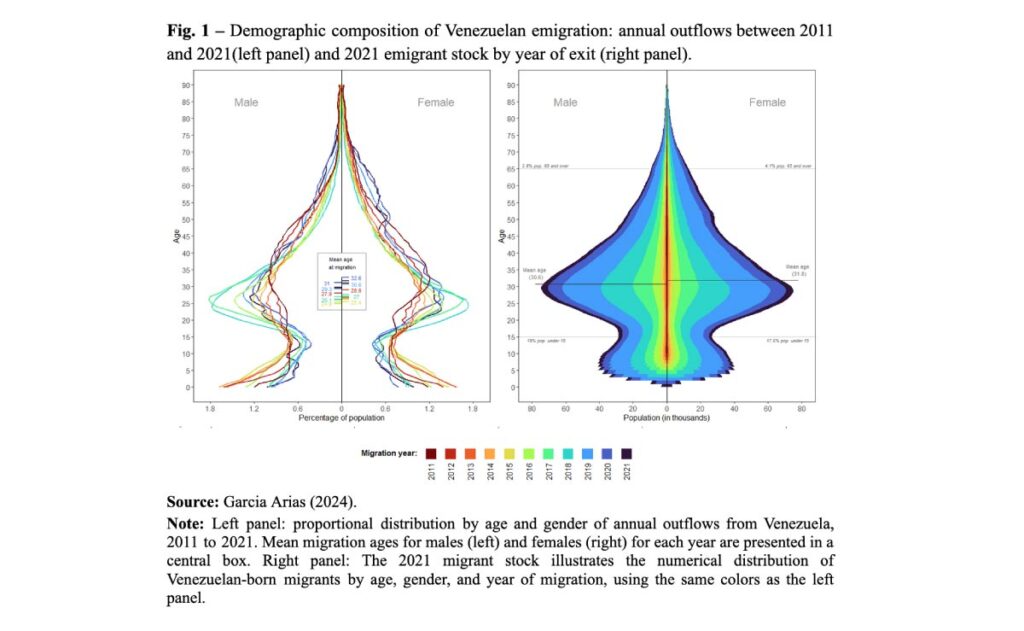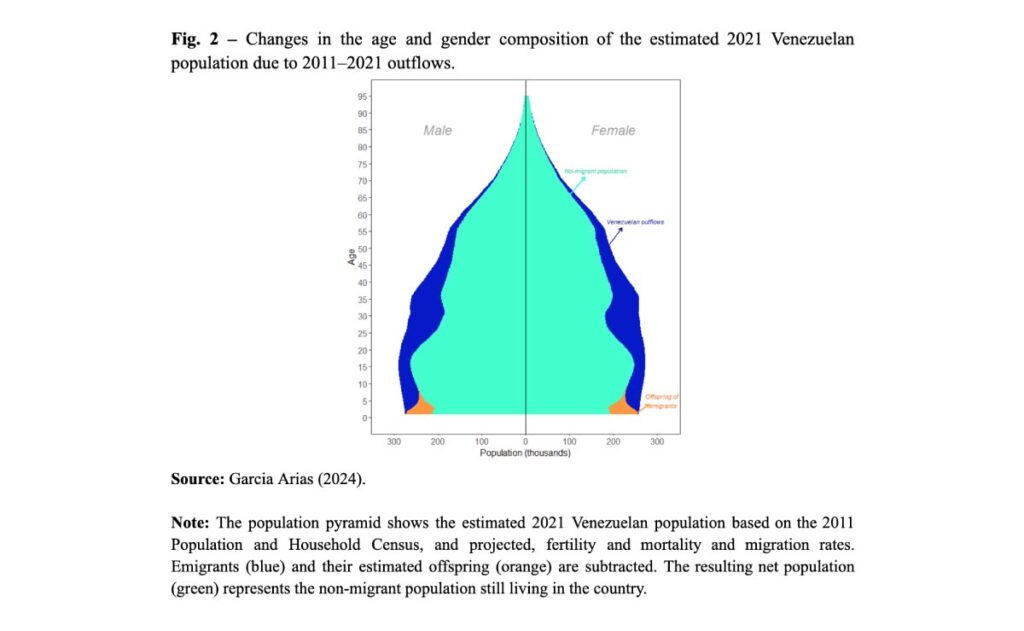The crisis-driven shifts of Venezuelan migration patterns

The Venezuelan exodus stands as the largest displacement in recent Latin American history, with around 22.5% of the population now living abroad. Drawing on data from seven of the main destination countries for Venezuelans, Jenny Garcia estimates the demographics of recent outflows, the chronology of associated changes, and the implications for those remaining in the country.
When a crisis occurs, demographic patterns can shift dramatically, leading to rapid changes in outward migration and local population compositions. As the crisis progresses, the likelihood of migration varies across individuals, influenced by the evolving costs and benefits of this choice. Accurately assessing population at risk is crucial for understanding levels and trends in demographic phenomena, and precise age and gender estimates are essential for evaluating the full impact of the ongoing crisis on both migrants and the remaining population.
The Venezuelan crisis
The recent Venezuelan migration crisis exemplifies how socio-economic and political instability can precipitate significant demographic shifts. The situation in Venezuela, formerly a destination for migrants, has undergone a dramatic reversal, resulting in one of the largest population exoduses in recent history, and the largest in recent Latin American history. According to the Inter-Agency Coordination Platform for Refugees and Migrants from Venezuela (R4V), as of June 2024, 7.7 million Venezuelans are living abroad, constituting approximately 22.5% of the estimated population (R4V, 2024).
The roots of the Venezuelan migration crisis are deeply embedded in the country’s economic collapse. A pivotal moment occurred in 2015, following the decline in oil prices that plunged Venezuela into a profound recession. The period from 2018 to 2019 was especially devastating, marked by hyperinflation, above 65%, and a 35% contraction in GDP. These economic adversities were compounded by extreme poverty, with 75% of the population living in severe hardship and nearly 90% of households unable to meet basic food needs (ENCOVI, 2022). The deteriorating quality of life, characterized by rampant crime, food scarcity, and human rights violations, forced many Venezuelans to flee.
Current research on Venezuelan migrants focuses on analyses conducted in receiving countries, and most estimates have highlighted the fluctuating size of the emigrant population throughout the crisis. However, there is limited understanding of the demographic characteristics of these crisis-driven outflows. This gap in knowledge is primarily attributed to the lack of available data, as Venezuela does not maintain emigration records, and data collection practices differ across receiving countries.
In a recent study (Garcia Arias, 2024) I explored the demographic dynamics of the emigrant Venezuelan population by estimating annual age and gender-specific outflows between 2011 and 2021 and summarizing the demographic implications for both emigrants and those remaining in the country. To do this, I exploited data from seven major destination countries, accounting for approximately 90% of the Venezuelan-born population residing abroad as of April 2022. The data sources included administrative records, population censuses, migrant surveys, continuous household surveys, and population registries.
The changing demography of outflows
In the 1990s, the number of Venezuelans living abroad was slightly over 185,000, increasing to 317,000 by 2000 and approximately 560,000 by 2010 (UN DESA 2020). These emigrants were predominantly members of Venezuela’s middle and upper classes, including businesspeople, highly skilled professionals—especially former oil industry employees—and first or second-generation descendants of immigrants to Venezuela. Their primary destinations included the United States, Spain, Italy, and Portugal (Freitez 2011). These outflows were predominantly female (55%), with a mean age of about 28.2 years.
Three key phases have since marked the crisis-induced changes in the demographics of Venezuelan emigration:
1) The onset of the crisis (2014-2017) marked a shift from highly skilled labor migration to family migration. The Venezuelan diaspora increased from 800,000 nationals abroad in 2014 to 2 million in 2017. The average age of these additional 1.21 million migrants dropped to its lowest level in 2015 (24.9 years for men and 25.4 years for women), and about 26% were under 15 years of age. These outflows largely consisted of entire families, often binational, seeking nearby destinations. Countries such as Colombia, Chile, Peru, and Ecuador emerged as primary destinations for Venezuelans. The incipient crisis also prompted a large number of young men to migrate; for the first time, the number of migrating men surpassed that of women (102 men per 100 women).
2) Acute phase of the crisis (2018-2020): During this period, 3.52 million Venezuelans left the country. Adults aged 20 to 45 constituted 54% of outflows, with women outnumbering men (95 men per 100 women). Only 18% of emigrants were under 15 years old. This phase was marked by a large portion of young women traveling alone. Migration patterns diversified, with an increasing number of middle- and lower-income individuals among outflows. People from across the entire country migrated; medium-sized and small towns replaced the historical role of the major cities as the main sources of migrants (ENCOVI 2022).
3) Impact of the COVID-19 pandemic (2021): The pandemic influenced migration trends, with continued, albeit reduced, emigration driven by family reunification. The proportion of older adults over 55 years, particularly women, among total outflows increased from 5% (2014-2017) to 12%. Additionally, Venezuelan migrants previously settled in southern countries of the American continent started redirecting their destinations towards the north.

By 2021, 63.6% of Venezuelans living abroad were between 15 and 45 years old, 16.1% were under 15 years old, and the remaining 20.3% were aged 46 years or older. Among this population, 49% were men and 51% were women.
The demography of those who remain
The mass emigration from Venezuela has profound implications for those who remain. The migration-induced changes have resulted in an 18% loss of the population aged 15 to 64 and a 20% loss of women of reproductive age (15 to 49 years). Consequently, the proportion of the elderly population (65 years or older) is 10% larger than it would otherwise have been. Furthermore, the large-scale emigration of women of reproductive age has led to a cumulative birth deficit since 2014 exceeding 500,000, equivalent to about a year without births in the country.

The repercussions of outmigration will extend beyond a mere reduction in the working-age population and accelerated population aging in coming years; the future functionality of Venezuela’s labor market is also profoundly affected. At the micro level, families left behind face additional challenges, including increased caregiving responsibilities.
The demographic characteristics of this crisis-driven migration, coupled with its prolonged duration, significantly reduce the likelihood of substantial return migration in the coming years. This situation is further compounded by the widespread lack of confidence in national institutions and political freedoms. To date, only negligible return migration has been reported, and when it does occur, it often serves as a strategy to redirect migration toward another destination. Thus, migration has surpassed both fertility and mortality as the primary driver of demographic change in Venezuela.
References
Garcia Arias, J. (2024), The Demography of Crisis-Driven Outflows from Venezuela. Population and Development Review. https://doi.org/10.1111/padr.12651
Encuesta de Condiciones de Vida- ENCOVI. 2022. “Informe de resultados.” Caracas: UCAB-Universidad Católica Andrés Bello.
Freitez, A. 2011. “La emigración desde Venezuela durante la última década.” Temas De Coyuntura, 63 (January): 11–38.
R4V. 2024. Coordination platform for refugees and migrants from Venezuela.
United Nations (2020). International Migrant Stock 2020: Highlights. New York. Department of Economic and Social Affairs. Population Division.